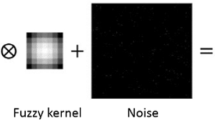Abstract
One of the most common image artifacts is blurring. Blind methods have been developed to restore a clear image from blurred input. In this paper, we introduce a new method which optimizes previous works and adapted with medical images. Optimized non-linear anisotropic diffusion was used to reduce noise by choosing constants correctly. After de-noising, edge sharpening is done using shock filters. A novel enhanced method called Coherence-Enhancing shock filters helped us to have strong sharpened edges. To obtain a blur kernel, we used the coarse-to-fine method. In the last step, we used spatial prior before restoring the unblurred image. Experiments with images show that combining these methods may outperform previous image restoration techniques in order to obtain reliable accuracy.
Access this chapter
Tax calculation will be finalised at checkout
Purchases are for personal use only
Similar content being viewed by others
References
Cho S, Lee S (2009) Fast motion deblurring. ACM Trans Graph (TOG) 28(5):145
Fergus R, Singh B, Hertzmann A, Roweis ST, Freeman WT (2006) Removing camera shake from a single photograph. ACM Trans Graph (TOG) 25(3):787–794
Yadav S, Jain C, Chugh A (2016) Evaluation of image deblurring techniques. Int J Comput Appl 139(12):32–36
Shan Q, Jia J, Agarwala A (2008) High-quality motion deblurring from a single image. ACM Trans Graph (TOG) 27(3)
Levin A, Weiss Y, Durand F, Freeman WT (2009) Understanding and evaluating blind deconvolution algorithms. In: IEEE conference on computer vision and pattern recognition, pp 1964–1971
Money J, Kang S (2008) Total variation minimizing blind deconvolution with shock filter reference. Image Vis Comput 26(2):302–314
Alvarez L, Mazorra L (1994) Signal and image restoration using shock filters and anisotropic diffusion. SIAM J Numer Anal 31(2):590–605
Xu L, Zheng S, Jia J (2013) Unnatural l0 sparse representation for natural image deblurring. In: Computer vision and pattern recognition, pp 1107–1114
Chen T, Huang TS, Yin W, Zhou XS (2005) A new coarse-to-fine framework for 3D brain MR image registration. In: International workshop on computer vision for biomedical image applications, pp 114–124. Springer, Heidelberg, October 2005
Perona P, Malik J (1987) Scale-space and edge detection using anisotropic diffusion. IEEE Trans Pattern Anal Mach Intell 12(7):629–639
Black MJ, Sapiro G, Marimont DH, Heeger D (1998) Robust anisotropic diffusion. IEEE Trans Image Process 7(3):421–432
Hasanpor H, Nikpour M (2008) Using adaptive diffusion coefficient to eliminate image noise using partial equations. Iranian J Electr Comput Eng 6(4)
Osher S, Rudin LI (1990) Feature-oriented image enhancement using shock filters. SIAM J Numer Anal 27(4):919–940
Weickert J (2003) Coherence-enhancing shock filters. In: Joint pattern recognition symposium. Springer, Berlin, pp 1–8
Xu L, Jia J (2010) Two-phase kernel estimation for robust motion deblurring. In: European conference on computer vision. Springer, Berlin, pp 157–170
Acknowledgements
The authors appreciate those who contributed to make this research successful. This research is supported by Center for Research and Innovation (PPPI) and Faculty of Engineering, Universiti Malaysia Sabah (UMS) under the Research Grant (SBK0393-2018).
Author information
Authors and Affiliations
Corresponding author
Editor information
Editors and Affiliations
Rights and permissions
Copyright information
© 2021 Springer Nature Singapore Pte Ltd.
About this paper
Cite this paper
Amini Gougeh, R., Yousefi Rezaii, T., Farzamnia, A. (2021). Medical Image Enhancement and Deblurring. In: Md Zain, Z., et al. Proceedings of the 11th National Technical Seminar on Unmanned System Technology 2019 . NUSYS 2019. Lecture Notes in Electrical Engineering, vol 666. Springer, Singapore. https://doi.org/10.1007/978-981-15-5281-6_38
Download citation
DOI: https://doi.org/10.1007/978-981-15-5281-6_38
Published:
Publisher Name: Springer, Singapore
Print ISBN: 978-981-15-5280-9
Online ISBN: 978-981-15-5281-6
eBook Packages: Intelligent Technologies and RoboticsIntelligent Technologies and Robotics (R0)




